Healthcare Interventions for Patients with Critical Illness
VerifiedAdded on 2023/01/19
|7
|1583
|29
AI Summary
This document discusses healthcare interventions for patients suffering from critical illness and the application of the clinical reasoning cycle for nursing priorities. It focuses on the case of Marcel Lever, a retired farmer with diabetes, and identifies two nursing priorities: overweight condition management and medication management literacy.
Contribute Materials
Your contribution can guide someone’s learning journey. Share your
documents today.
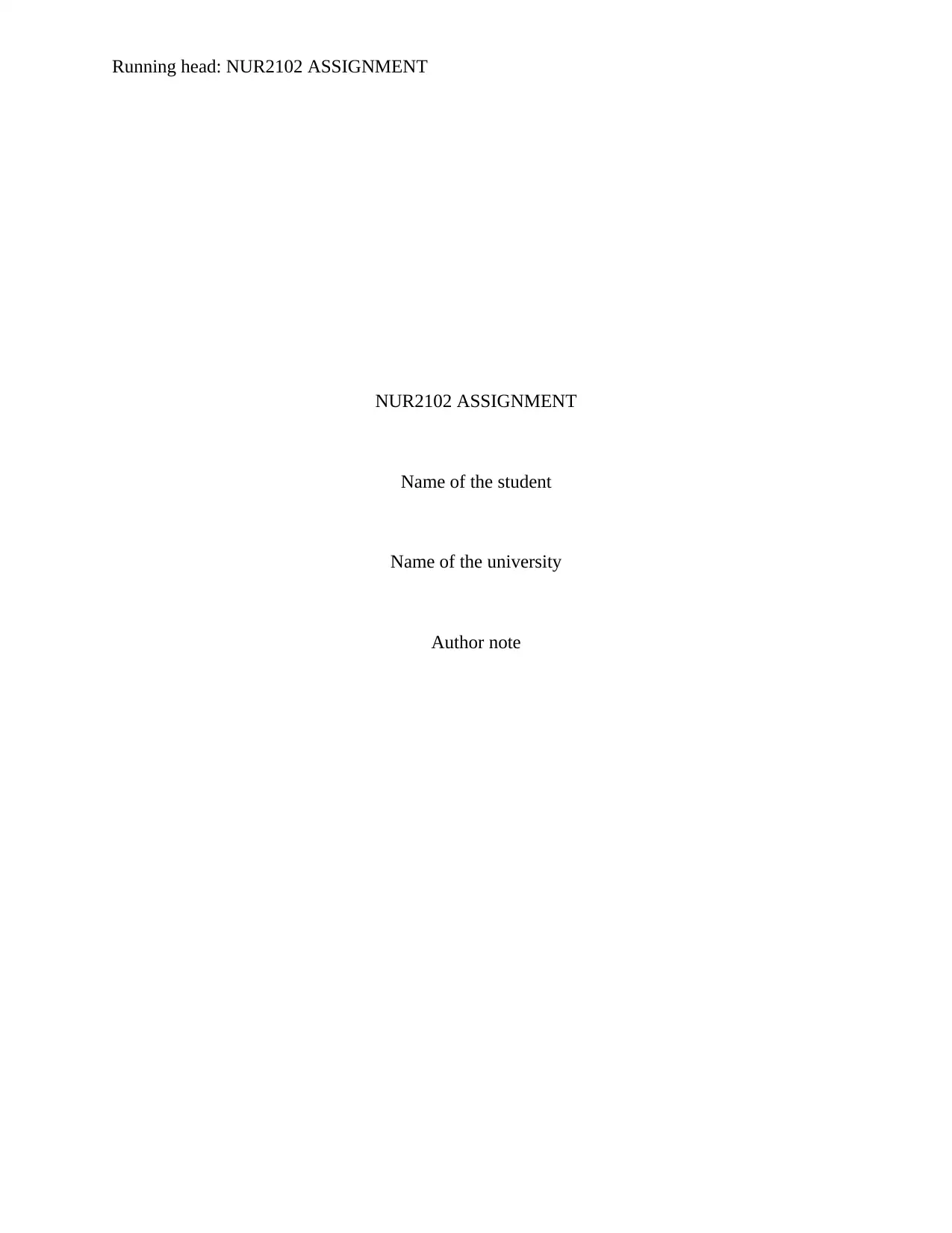
Running head: NUR2102 ASSIGNMENT
NUR2102 ASSIGNMENT
Name of the student
Name of the university
Author note
NUR2102 ASSIGNMENT
Name of the student
Name of the university
Author note
Secure Best Marks with AI Grader
Need help grading? Try our AI Grader for instant feedback on your assignments.
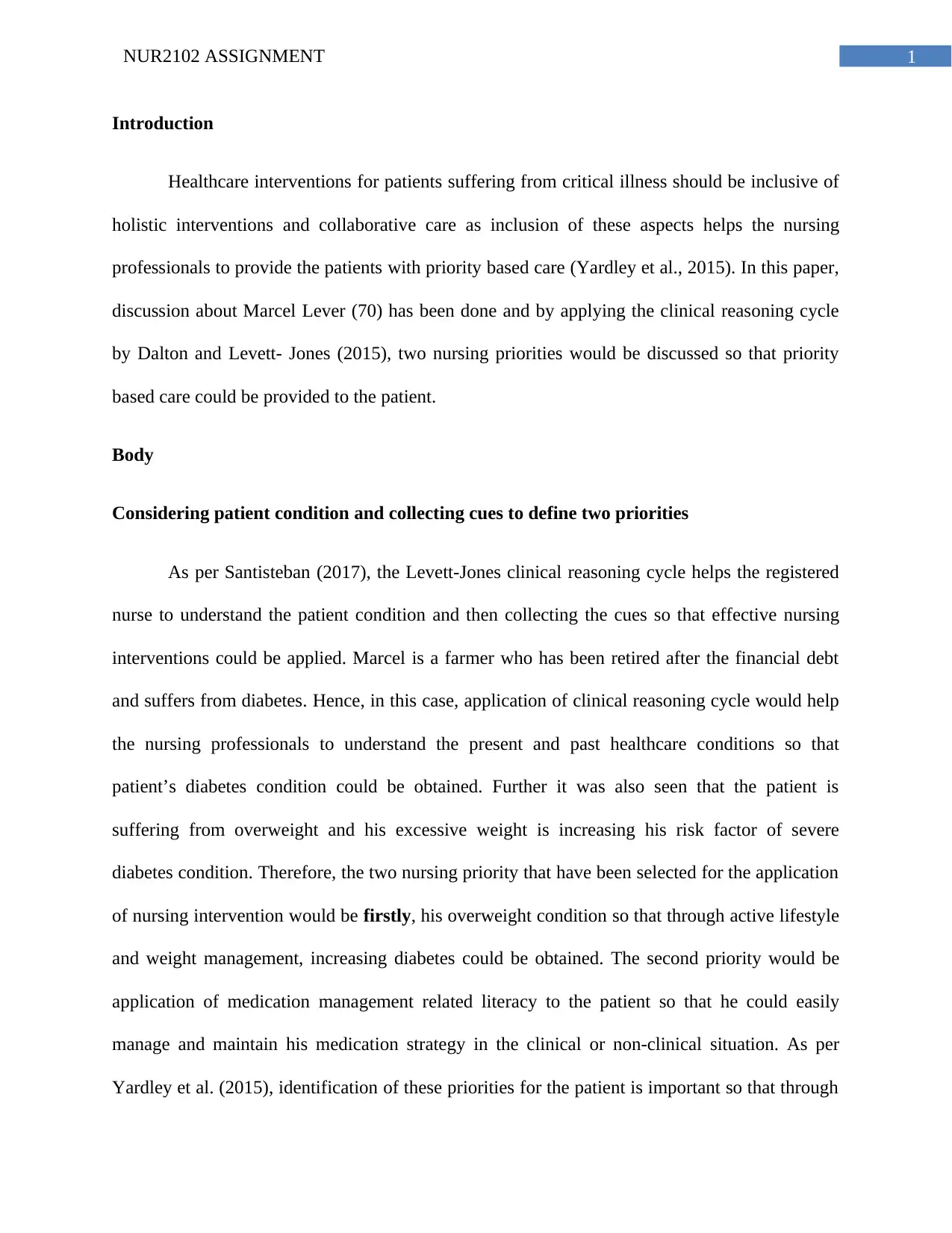
1NUR2102 ASSIGNMENT
Introduction
Healthcare interventions for patients suffering from critical illness should be inclusive of
holistic interventions and collaborative care as inclusion of these aspects helps the nursing
professionals to provide the patients with priority based care (Yardley et al., 2015). In this paper,
discussion about Marcel Lever (70) has been done and by applying the clinical reasoning cycle
by Dalton and Levett- Jones (2015), two nursing priorities would be discussed so that priority
based care could be provided to the patient.
Body
Considering patient condition and collecting cues to define two priorities
As per Santisteban (2017), the Levett-Jones clinical reasoning cycle helps the registered
nurse to understand the patient condition and then collecting the cues so that effective nursing
interventions could be applied. Marcel is a farmer who has been retired after the financial debt
and suffers from diabetes. Hence, in this case, application of clinical reasoning cycle would help
the nursing professionals to understand the present and past healthcare conditions so that
patient’s diabetes condition could be obtained. Further it was also seen that the patient is
suffering from overweight and his excessive weight is increasing his risk factor of severe
diabetes condition. Therefore, the two nursing priority that have been selected for the application
of nursing intervention would be firstly, his overweight condition so that through active lifestyle
and weight management, increasing diabetes could be obtained. The second priority would be
application of medication management related literacy to the patient so that he could easily
manage and maintain his medication strategy in the clinical or non-clinical situation. As per
Yardley et al. (2015), identification of these priorities for the patient is important so that through
Introduction
Healthcare interventions for patients suffering from critical illness should be inclusive of
holistic interventions and collaborative care as inclusion of these aspects helps the nursing
professionals to provide the patients with priority based care (Yardley et al., 2015). In this paper,
discussion about Marcel Lever (70) has been done and by applying the clinical reasoning cycle
by Dalton and Levett- Jones (2015), two nursing priorities would be discussed so that priority
based care could be provided to the patient.
Body
Considering patient condition and collecting cues to define two priorities
As per Santisteban (2017), the Levett-Jones clinical reasoning cycle helps the registered
nurse to understand the patient condition and then collecting the cues so that effective nursing
interventions could be applied. Marcel is a farmer who has been retired after the financial debt
and suffers from diabetes. Hence, in this case, application of clinical reasoning cycle would help
the nursing professionals to understand the present and past healthcare conditions so that
patient’s diabetes condition could be obtained. Further it was also seen that the patient is
suffering from overweight and his excessive weight is increasing his risk factor of severe
diabetes condition. Therefore, the two nursing priority that have been selected for the application
of nursing intervention would be firstly, his overweight condition so that through active lifestyle
and weight management, increasing diabetes could be obtained. The second priority would be
application of medication management related literacy to the patient so that he could easily
manage and maintain his medication strategy in the clinical or non-clinical situation. As per
Yardley et al. (2015), identification of these priorities for the patient is important so that through
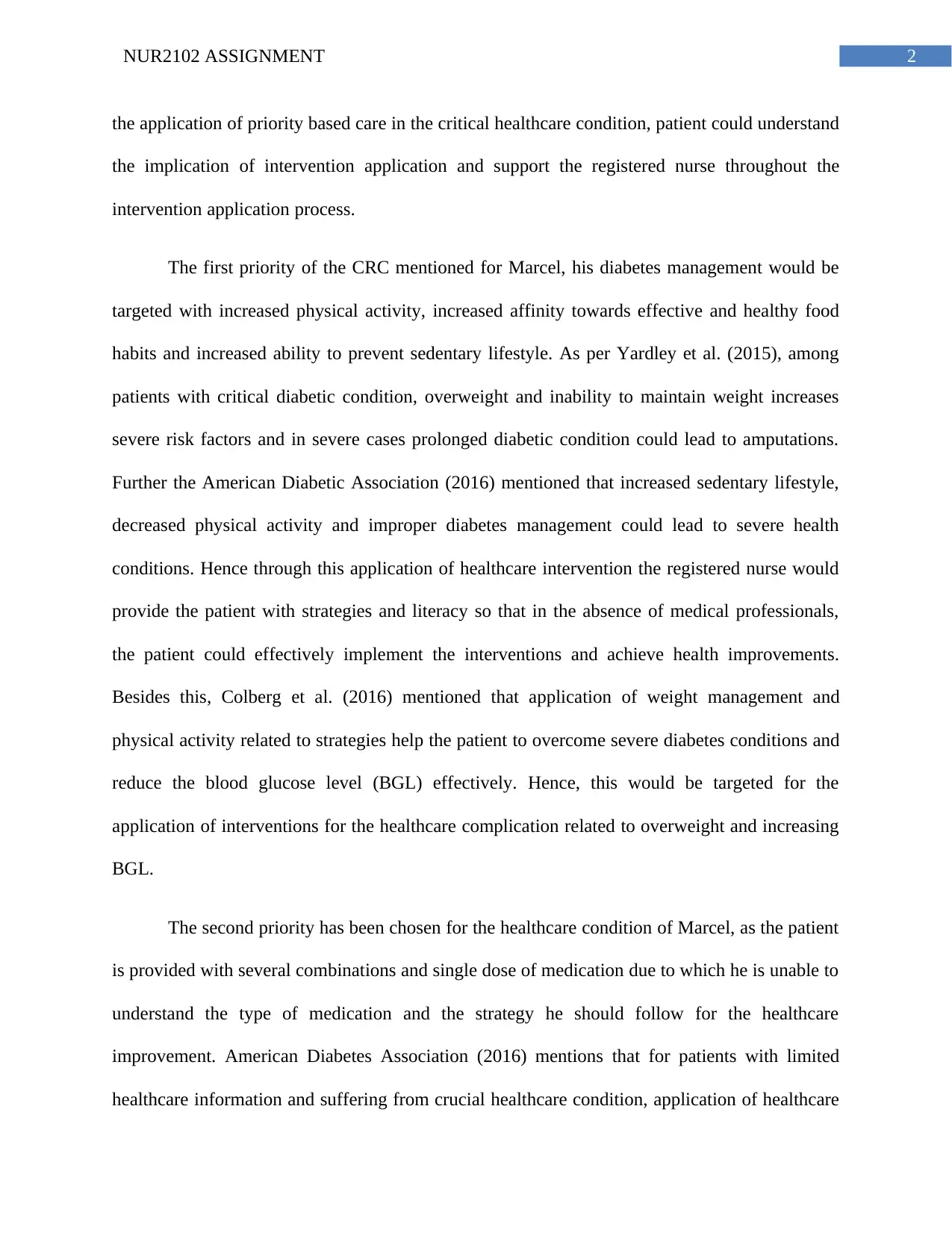
2NUR2102 ASSIGNMENT
the application of priority based care in the critical healthcare condition, patient could understand
the implication of intervention application and support the registered nurse throughout the
intervention application process.
The first priority of the CRC mentioned for Marcel, his diabetes management would be
targeted with increased physical activity, increased affinity towards effective and healthy food
habits and increased ability to prevent sedentary lifestyle. As per Yardley et al. (2015), among
patients with critical diabetic condition, overweight and inability to maintain weight increases
severe risk factors and in severe cases prolonged diabetic condition could lead to amputations.
Further the American Diabetic Association (2016) mentioned that increased sedentary lifestyle,
decreased physical activity and improper diabetes management could lead to severe health
conditions. Hence through this application of healthcare intervention the registered nurse would
provide the patient with strategies and literacy so that in the absence of medical professionals,
the patient could effectively implement the interventions and achieve health improvements.
Besides this, Colberg et al. (2016) mentioned that application of weight management and
physical activity related to strategies help the patient to overcome severe diabetes conditions and
reduce the blood glucose level (BGL) effectively. Hence, this would be targeted for the
application of interventions for the healthcare complication related to overweight and increasing
BGL.
The second priority has been chosen for the healthcare condition of Marcel, as the patient
is provided with several combinations and single dose of medication due to which he is unable to
understand the type of medication and the strategy he should follow for the healthcare
improvement. American Diabetes Association (2016) mentions that for patients with limited
healthcare information and suffering from crucial healthcare condition, application of healthcare
the application of priority based care in the critical healthcare condition, patient could understand
the implication of intervention application and support the registered nurse throughout the
intervention application process.
The first priority of the CRC mentioned for Marcel, his diabetes management would be
targeted with increased physical activity, increased affinity towards effective and healthy food
habits and increased ability to prevent sedentary lifestyle. As per Yardley et al. (2015), among
patients with critical diabetic condition, overweight and inability to maintain weight increases
severe risk factors and in severe cases prolonged diabetic condition could lead to amputations.
Further the American Diabetic Association (2016) mentioned that increased sedentary lifestyle,
decreased physical activity and improper diabetes management could lead to severe health
conditions. Hence through this application of healthcare intervention the registered nurse would
provide the patient with strategies and literacy so that in the absence of medical professionals,
the patient could effectively implement the interventions and achieve health improvements.
Besides this, Colberg et al. (2016) mentioned that application of weight management and
physical activity related to strategies help the patient to overcome severe diabetes conditions and
reduce the blood glucose level (BGL) effectively. Hence, this would be targeted for the
application of interventions for the healthcare complication related to overweight and increasing
BGL.
The second priority has been chosen for the healthcare condition of Marcel, as the patient
is provided with several combinations and single dose of medication due to which he is unable to
understand the type of medication and the strategy he should follow for the healthcare
improvement. American Diabetes Association (2016) mentions that for patients with limited
healthcare information and suffering from crucial healthcare condition, application of healthcare
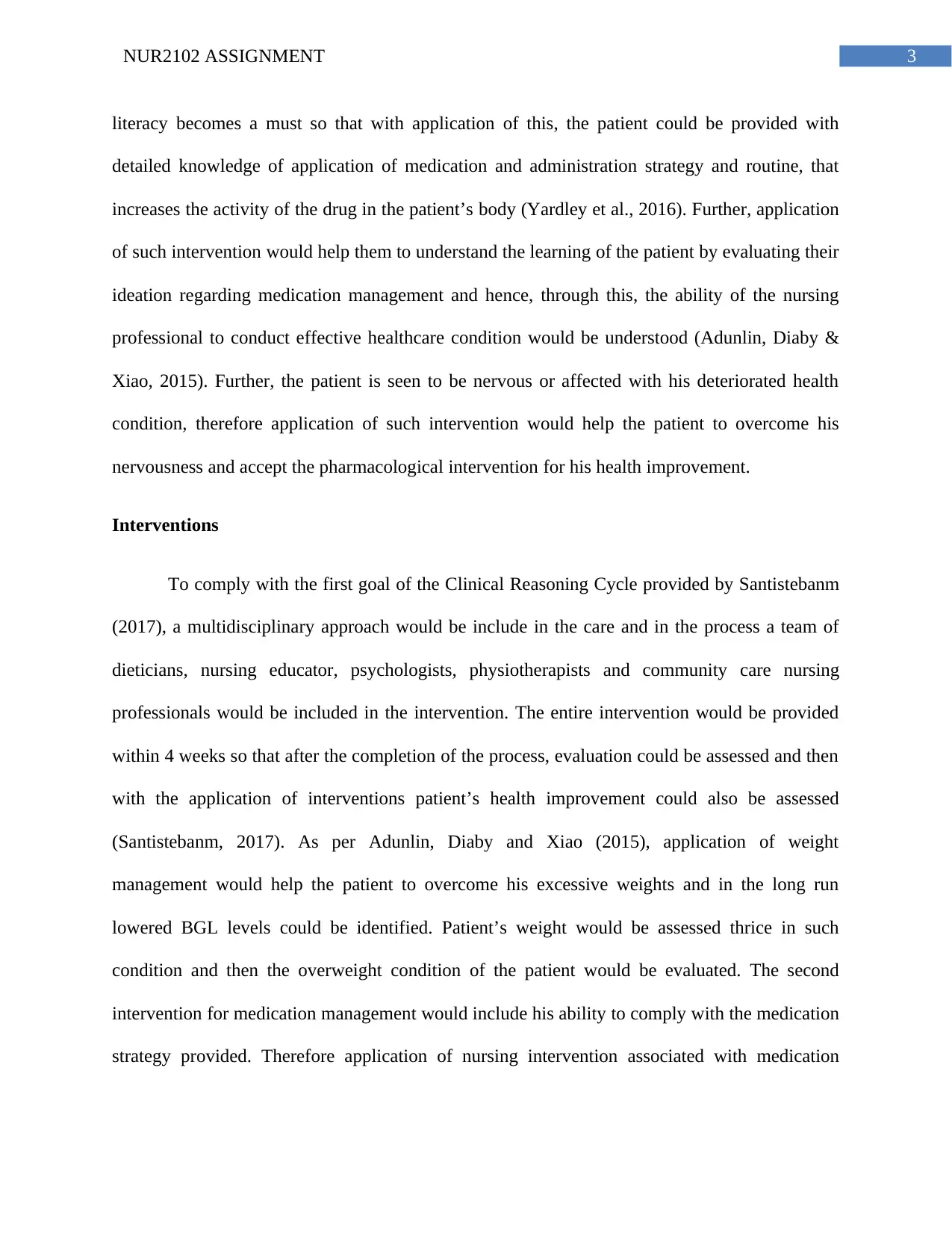
3NUR2102 ASSIGNMENT
literacy becomes a must so that with application of this, the patient could be provided with
detailed knowledge of application of medication and administration strategy and routine, that
increases the activity of the drug in the patient’s body (Yardley et al., 2016). Further, application
of such intervention would help them to understand the learning of the patient by evaluating their
ideation regarding medication management and hence, through this, the ability of the nursing
professional to conduct effective healthcare condition would be understood (Adunlin, Diaby &
Xiao, 2015). Further, the patient is seen to be nervous or affected with his deteriorated health
condition, therefore application of such intervention would help the patient to overcome his
nervousness and accept the pharmacological intervention for his health improvement.
Interventions
To comply with the first goal of the Clinical Reasoning Cycle provided by Santistebanm
(2017), a multidisciplinary approach would be include in the care and in the process a team of
dieticians, nursing educator, psychologists, physiotherapists and community care nursing
professionals would be included in the intervention. The entire intervention would be provided
within 4 weeks so that after the completion of the process, evaluation could be assessed and then
with the application of interventions patient’s health improvement could also be assessed
(Santistebanm, 2017). As per Adunlin, Diaby and Xiao (2015), application of weight
management would help the patient to overcome his excessive weights and in the long run
lowered BGL levels could be identified. Patient’s weight would be assessed thrice in such
condition and then the overweight condition of the patient would be evaluated. The second
intervention for medication management would include his ability to comply with the medication
strategy provided. Therefore application of nursing intervention associated with medication
literacy becomes a must so that with application of this, the patient could be provided with
detailed knowledge of application of medication and administration strategy and routine, that
increases the activity of the drug in the patient’s body (Yardley et al., 2016). Further, application
of such intervention would help them to understand the learning of the patient by evaluating their
ideation regarding medication management and hence, through this, the ability of the nursing
professional to conduct effective healthcare condition would be understood (Adunlin, Diaby &
Xiao, 2015). Further, the patient is seen to be nervous or affected with his deteriorated health
condition, therefore application of such intervention would help the patient to overcome his
nervousness and accept the pharmacological intervention for his health improvement.
Interventions
To comply with the first goal of the Clinical Reasoning Cycle provided by Santistebanm
(2017), a multidisciplinary approach would be include in the care and in the process a team of
dieticians, nursing educator, psychologists, physiotherapists and community care nursing
professionals would be included in the intervention. The entire intervention would be provided
within 4 weeks so that after the completion of the process, evaluation could be assessed and then
with the application of interventions patient’s health improvement could also be assessed
(Santistebanm, 2017). As per Adunlin, Diaby and Xiao (2015), application of weight
management would help the patient to overcome his excessive weights and in the long run
lowered BGL levels could be identified. Patient’s weight would be assessed thrice in such
condition and then the overweight condition of the patient would be evaluated. The second
intervention for medication management would include his ability to comply with the medication
strategy provided. Therefore application of nursing intervention associated with medication
Secure Best Marks with AI Grader
Need help grading? Try our AI Grader for instant feedback on your assignments.
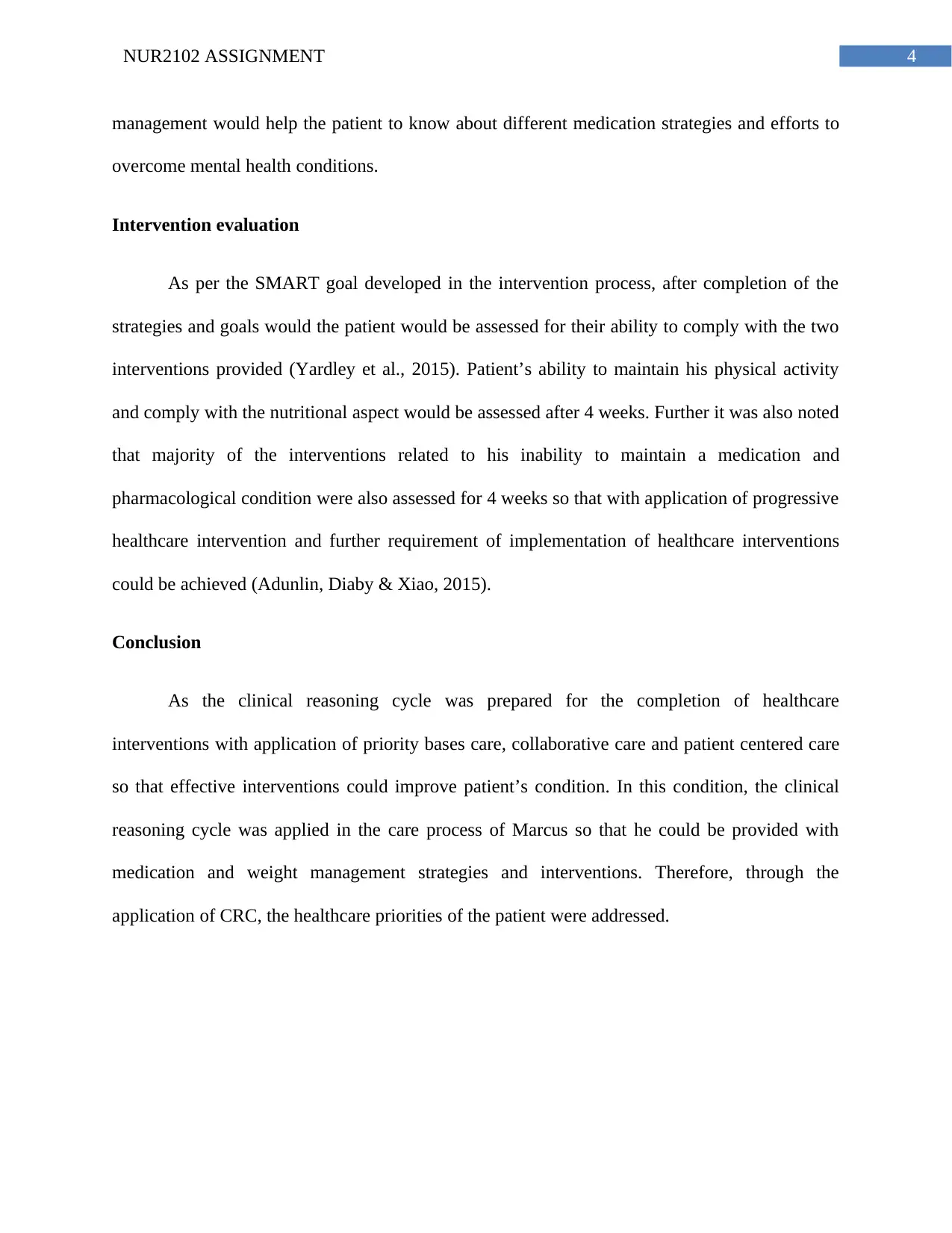
4NUR2102 ASSIGNMENT
management would help the patient to know about different medication strategies and efforts to
overcome mental health conditions.
Intervention evaluation
As per the SMART goal developed in the intervention process, after completion of the
strategies and goals would the patient would be assessed for their ability to comply with the two
interventions provided (Yardley et al., 2015). Patient’s ability to maintain his physical activity
and comply with the nutritional aspect would be assessed after 4 weeks. Further it was also noted
that majority of the interventions related to his inability to maintain a medication and
pharmacological condition were also assessed for 4 weeks so that with application of progressive
healthcare intervention and further requirement of implementation of healthcare interventions
could be achieved (Adunlin, Diaby & Xiao, 2015).
Conclusion
As the clinical reasoning cycle was prepared for the completion of healthcare
interventions with application of priority bases care, collaborative care and patient centered care
so that effective interventions could improve patient’s condition. In this condition, the clinical
reasoning cycle was applied in the care process of Marcus so that he could be provided with
medication and weight management strategies and interventions. Therefore, through the
application of CRC, the healthcare priorities of the patient were addressed.
management would help the patient to know about different medication strategies and efforts to
overcome mental health conditions.
Intervention evaluation
As per the SMART goal developed in the intervention process, after completion of the
strategies and goals would the patient would be assessed for their ability to comply with the two
interventions provided (Yardley et al., 2015). Patient’s ability to maintain his physical activity
and comply with the nutritional aspect would be assessed after 4 weeks. Further it was also noted
that majority of the interventions related to his inability to maintain a medication and
pharmacological condition were also assessed for 4 weeks so that with application of progressive
healthcare intervention and further requirement of implementation of healthcare interventions
could be achieved (Adunlin, Diaby & Xiao, 2015).
Conclusion
As the clinical reasoning cycle was prepared for the completion of healthcare
interventions with application of priority bases care, collaborative care and patient centered care
so that effective interventions could improve patient’s condition. In this condition, the clinical
reasoning cycle was applied in the care process of Marcus so that he could be provided with
medication and weight management strategies and interventions. Therefore, through the
application of CRC, the healthcare priorities of the patient were addressed.
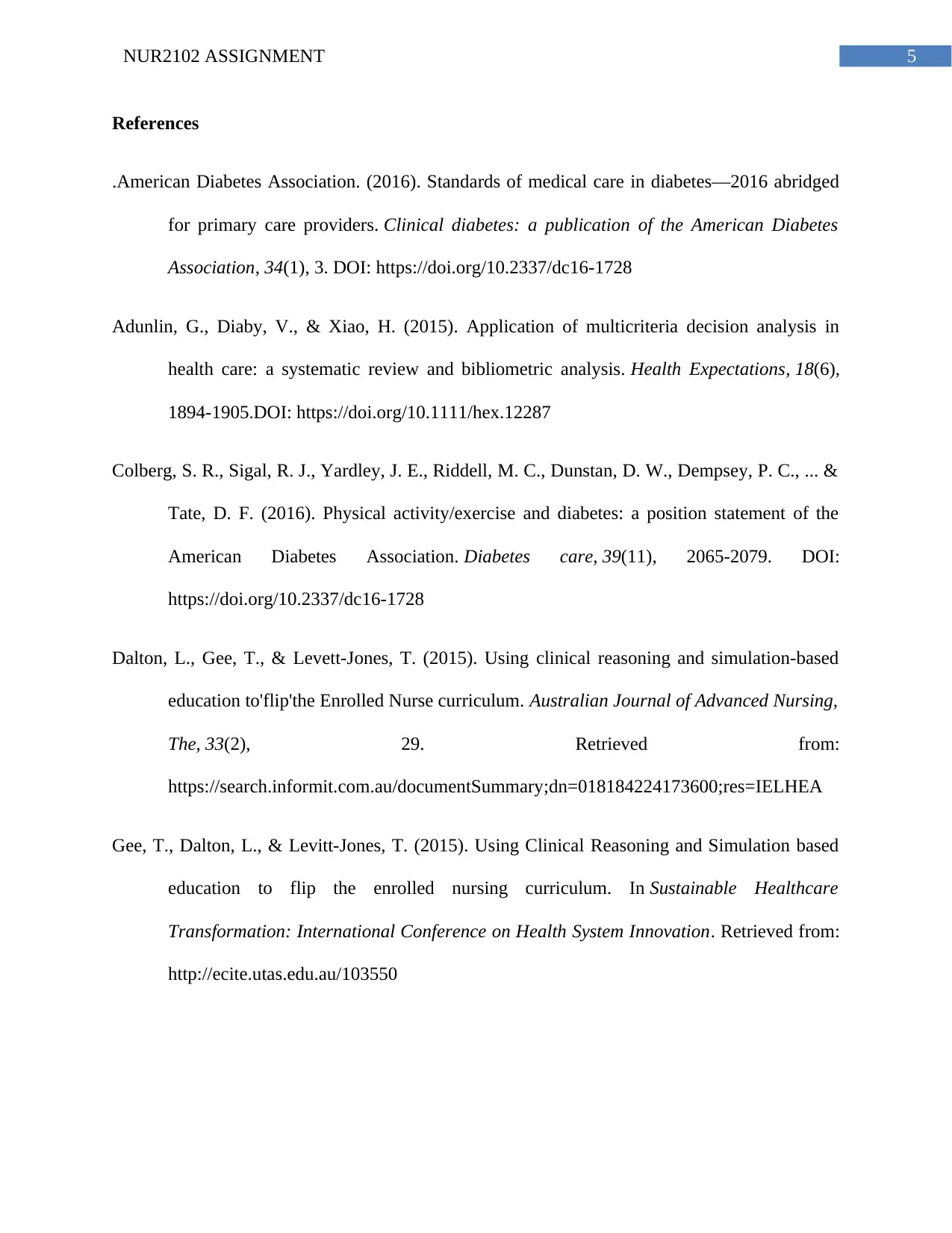
5NUR2102 ASSIGNMENT
References
.American Diabetes Association. (2016). Standards of medical care in diabetes—2016 abridged
for primary care providers. Clinical diabetes: a publication of the American Diabetes
Association, 34(1), 3. DOI: https://doi.org/10.2337/dc16-1728
Adunlin, G., Diaby, V., & Xiao, H. (2015). Application of multicriteria decision analysis in
health care: a systematic review and bibliometric analysis. Health Expectations, 18(6),
1894-1905.DOI: https://doi.org/10.1111/hex.12287
Colberg, S. R., Sigal, R. J., Yardley, J. E., Riddell, M. C., Dunstan, D. W., Dempsey, P. C., ... &
Tate, D. F. (2016). Physical activity/exercise and diabetes: a position statement of the
American Diabetes Association. Diabetes care, 39(11), 2065-2079. DOI:
https://doi.org/10.2337/dc16-1728
Dalton, L., Gee, T., & Levett-Jones, T. (2015). Using clinical reasoning and simulation-based
education to'flip'the Enrolled Nurse curriculum. Australian Journal of Advanced Nursing,
The, 33(2), 29. Retrieved from:
https://search.informit.com.au/documentSummary;dn=018184224173600;res=IELHEA
Gee, T., Dalton, L., & Levitt-Jones, T. (2015). Using Clinical Reasoning and Simulation based
education to flip the enrolled nursing curriculum. In Sustainable Healthcare
Transformation: International Conference on Health System Innovation. Retrieved from:
http://ecite.utas.edu.au/103550
References
.American Diabetes Association. (2016). Standards of medical care in diabetes—2016 abridged
for primary care providers. Clinical diabetes: a publication of the American Diabetes
Association, 34(1), 3. DOI: https://doi.org/10.2337/dc16-1728
Adunlin, G., Diaby, V., & Xiao, H. (2015). Application of multicriteria decision analysis in
health care: a systematic review and bibliometric analysis. Health Expectations, 18(6),
1894-1905.DOI: https://doi.org/10.1111/hex.12287
Colberg, S. R., Sigal, R. J., Yardley, J. E., Riddell, M. C., Dunstan, D. W., Dempsey, P. C., ... &
Tate, D. F. (2016). Physical activity/exercise and diabetes: a position statement of the
American Diabetes Association. Diabetes care, 39(11), 2065-2079. DOI:
https://doi.org/10.2337/dc16-1728
Dalton, L., Gee, T., & Levett-Jones, T. (2015). Using clinical reasoning and simulation-based
education to'flip'the Enrolled Nurse curriculum. Australian Journal of Advanced Nursing,
The, 33(2), 29. Retrieved from:
https://search.informit.com.au/documentSummary;dn=018184224173600;res=IELHEA
Gee, T., Dalton, L., & Levitt-Jones, T. (2015). Using Clinical Reasoning and Simulation based
education to flip the enrolled nursing curriculum. In Sustainable Healthcare
Transformation: International Conference on Health System Innovation. Retrieved from:
http://ecite.utas.edu.au/103550
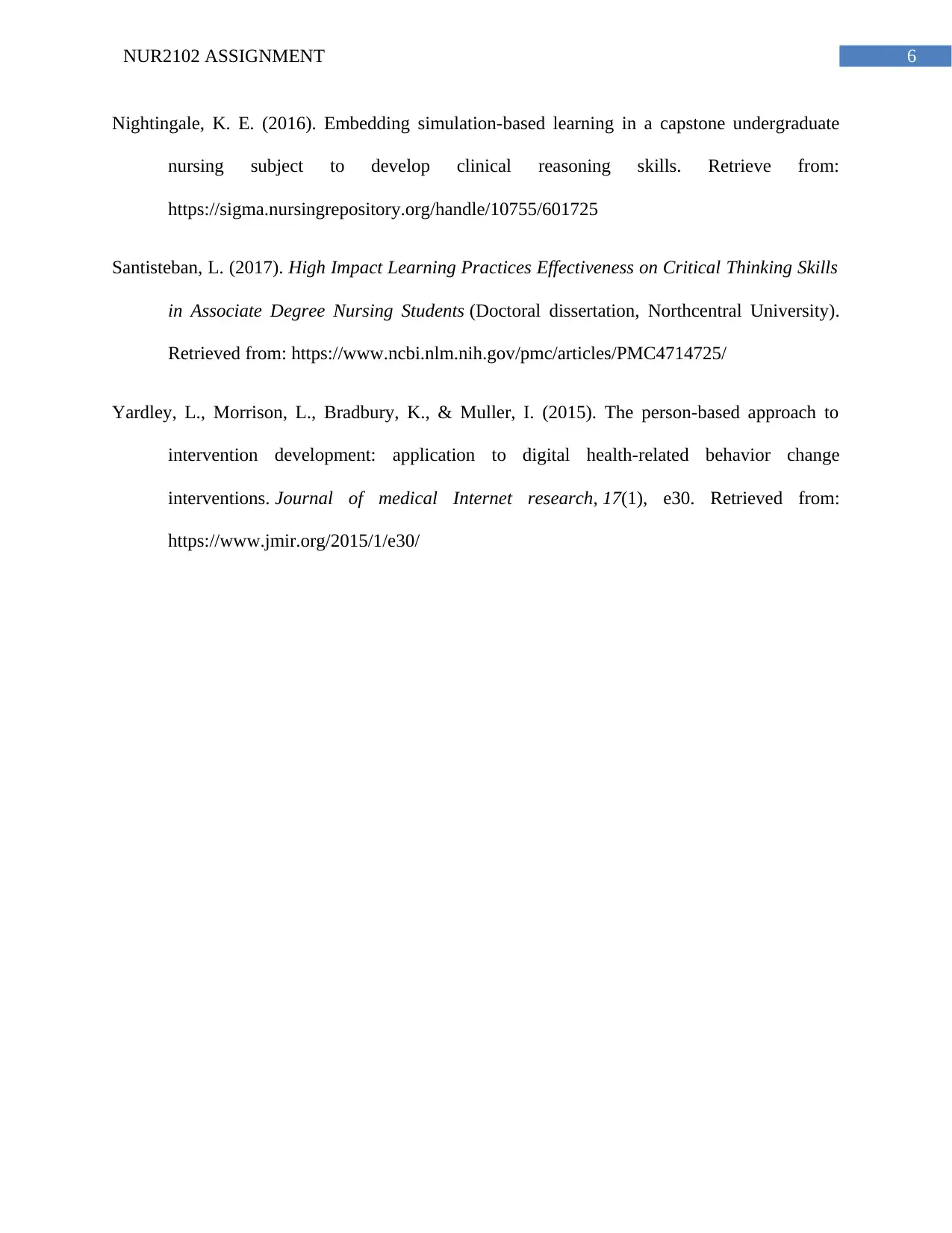
6NUR2102 ASSIGNMENT
Nightingale, K. E. (2016). Embedding simulation-based learning in a capstone undergraduate
nursing subject to develop clinical reasoning skills. Retrieve from:
https://sigma.nursingrepository.org/handle/10755/601725
Santisteban, L. (2017). High Impact Learning Practices Effectiveness on Critical Thinking Skills
in Associate Degree Nursing Students (Doctoral dissertation, Northcentral University).
Retrieved from: https://www.ncbi.nlm.nih.gov/pmc/articles/PMC4714725/
Yardley, L., Morrison, L., Bradbury, K., & Muller, I. (2015). The person-based approach to
intervention development: application to digital health-related behavior change
interventions. Journal of medical Internet research, 17(1), e30. Retrieved from:
https://www.jmir.org/2015/1/e30/
Nightingale, K. E. (2016). Embedding simulation-based learning in a capstone undergraduate
nursing subject to develop clinical reasoning skills. Retrieve from:
https://sigma.nursingrepository.org/handle/10755/601725
Santisteban, L. (2017). High Impact Learning Practices Effectiveness on Critical Thinking Skills
in Associate Degree Nursing Students (Doctoral dissertation, Northcentral University).
Retrieved from: https://www.ncbi.nlm.nih.gov/pmc/articles/PMC4714725/
Yardley, L., Morrison, L., Bradbury, K., & Muller, I. (2015). The person-based approach to
intervention development: application to digital health-related behavior change
interventions. Journal of medical Internet research, 17(1), e30. Retrieved from:
https://www.jmir.org/2015/1/e30/
1 out of 7
Related Documents
Your All-in-One AI-Powered Toolkit for Academic Success.
+13062052269
info@desklib.com
Available 24*7 on WhatsApp / Email
![[object Object]](/_next/static/media/star-bottom.7253800d.svg)
Unlock your academic potential
© 2024 | Zucol Services PVT LTD | All rights reserved.




